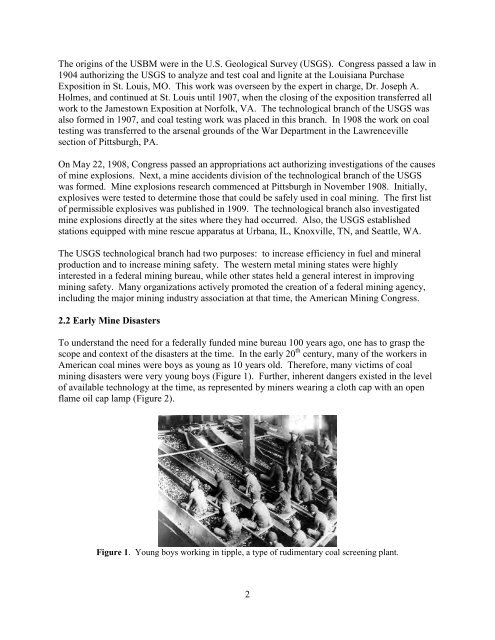One Hundred Years of Federal Mining Safety and Health Research
One Hundred Years of Federal Mining Safety and Health Research
One Hundred Years of Federal Mining Safety and Health Research
- No tags were found...
You also want an ePaper? Increase the reach of your titles
YUMPU automatically turns print PDFs into web optimized ePapers that Google loves.
The origins <strong>of</strong> the USBM were in the U.S. Geological Survey (USGS). Congress passed a law in<br />
1904 authorizing the USGS to analyze <strong>and</strong> test coal <strong>and</strong> lignite at the Louisiana Purchase<br />
Exposition in St. Louis, MO. This work was overseen by the expert in charge, Dr. Joseph A.<br />
Holmes, <strong>and</strong> continued at St. Louis until 1907, when the closing <strong>of</strong> the exposition transferred all<br />
work to the Jamestown Exposition at Norfolk, VA. The technological branch <strong>of</strong> the USGS was<br />
also formed in 1907, <strong>and</strong> coal testing work was placed in this branch. In 1908 the work on coal<br />
testing was transferred to the arsenal grounds <strong>of</strong> the War Department in the Lawrenceville<br />
section <strong>of</strong> Pittsburgh, PA.<br />
On May 22, 1908, Congress passed an appropriations act authorizing investigations <strong>of</strong> the causes<br />
<strong>of</strong> mine explosions. Next, a mine accidents division <strong>of</strong> the technological branch <strong>of</strong> the USGS<br />
was formed. Mine explosions research commenced at Pittsburgh in November 1908. Initially,<br />
explosives were tested to determine those that could be safely used in coal mining. The first list<br />
<strong>of</strong> permissible explosives was published in 1909. The technological branch also investigated<br />
mine explosions directly at the sites where they had occurred. Also, the USGS established<br />
stations equipped with mine rescue apparatus at Urbana, IL, Knoxville, TN, <strong>and</strong> Seattle, WA.<br />
The USGS technological branch had two purposes: to increase efficiency in fuel <strong>and</strong> mineral<br />
production <strong>and</strong> to increase mining safety. The western metal mining states were highly<br />
interested in a federal mining bureau, while other states held a general interest in improving<br />
mining safety. Many organizations actively promoted the creation <strong>of</strong> a federal mining agency,<br />
including the major mining industry association at that time, the American <strong>Mining</strong> Congress.<br />
2.2 Early Mine Disasters<br />
To underst<strong>and</strong> the need for a federally funded mine bureau 100 years ago, one has to grasp the<br />
scope <strong>and</strong> context <strong>of</strong> the disasters at the time. In the early 20 th century, many <strong>of</strong> the workers in<br />
American coal mines were boys as young as 10 years old. Therefore, many victims <strong>of</strong> coal<br />
mining disasters were very young boys (Figure 1). Further, inherent dangers existed in the level<br />
<strong>of</strong> available technology at the time, as represented by miners wearing a cloth cap with an open<br />
flame oil cap lamp (Figure 2).<br />
Figure 1. Young boys working in tipple, a type <strong>of</strong> rudimentary coal screening plant.<br />
2
















